What are the causes of pathological bone loss?
As a result of post-extraction bone resorption, periodontal infection, root canal infections or failures, dento-alveolar trauma, and traumatic tooth extraction it would be necessary to reconstruct or augment the alveolar bony ridge defect prior to, or simultaneous to implant placement to ensure that there is sufficient bone around the dental implants.
As a sequence of Periodontal disease, the crestal, and lateral aspects of the supporting bone walls and gum are collapsing rendering deficient bone ridge architecture. This provides inadequate implant support which can severely compromise both the long-term prognosis and aesthetics of implant-supported crowns and bridges.
As a sequence of root canal necrosis and chronic peri-apical infections the lateral and apical aspects of the supporting bone periphery walls destructed, while the sinus floor may directly or indirectly become infected and lose its integrity.
Hence both the apical and lateral aspects of the alveolar bone ridge architecture become deficient of adequate support for the future dental implant and compromise the primary stability and functional capacity of the dental implants, hence the long-term prognosis of implant-supported crowns and bridges.
What happens to the alveolar ridge after tooth extraction?
Based on the evidenced-based clinical and histological studies the preservation of alveolar bone architecture may depends on both physiologic and mechanical stimulation maintenance of tooth in the alveolar socket. The rate of the dimensional changes in the extraction site could be more rapid during the post-extraction immediate 2-3 months periods, while more gradual after that. The existence and resorption rate of the bundle bone which forms the walls of the tooth socket are dependent on the blood supply from the periodontal ligament, which disintegrates after the tooth extraction. It has been shown that horizontal bone loss progresses more extensively in the buccal-lingual direction.
What factors determine the rate and extent of post-extraction bone resorption?
Following tooth extraction, resorptive bone changes take place around the extraction site. The extent of post-extraction bone loss is influenced by the factors below: The traumatic nature of the root elevation and the type of the flap raised during the surgery (split thickness versus full thickness); Systemic and local biological health of the patient; Patient’s lifestyle, such as smoking; Number of roots; Pre-extraction dimensions of the peripheral alveolar bone; and Hard and soft tissue biotype.
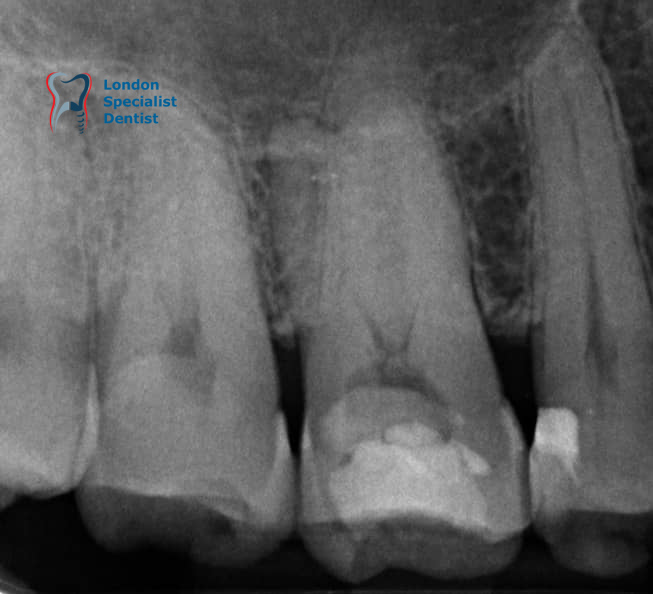
Before extraction
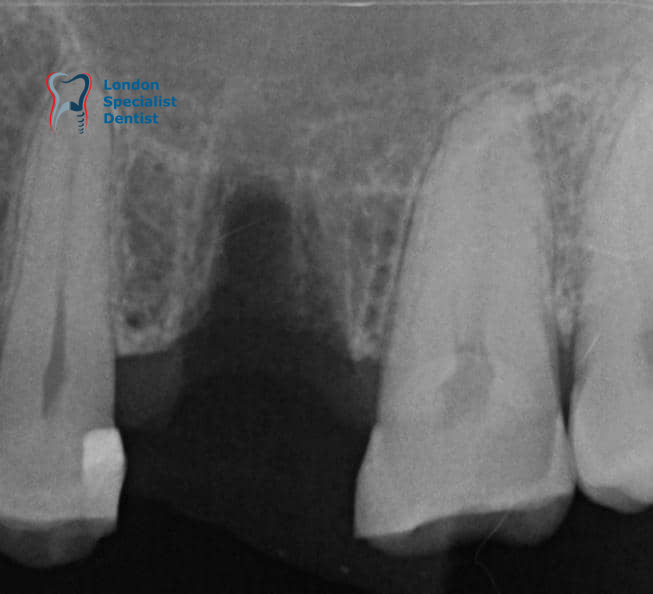
After extraction
How bone resorption progresses following tooth extraction?
According to scientific evidence:
– About 50% of the alveolar socket bone ridge width resorption occurs during the first year, with the highest resorption rate during the immediate post-extraction period by an average of 1mm within the first three months.
– Bone resorption occurs more extensively horizontally around the buccal bundle bone and around the anterior teeth as the buccal bone plate is thinner than the lingual side.
What is Guided Bone Regeneration?
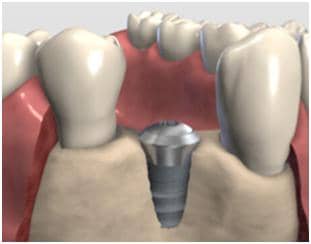
Exposed implant due to the localised bone resorption.

Bone regenerative procedure using bone graft material.
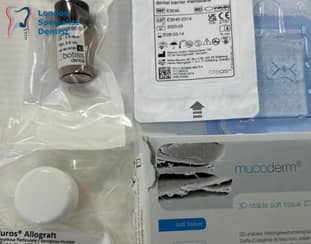
Guided bone regeneration (GBR) is a technique which is implemented to reconstruct and restore the bone deficiencies. This procedure may involve the use of a resorbable or non-resorbable membrane acting as a biological barrier which promote bone, enabling only the bone cells’ ingrowth and bone mineralisation around the defective alveolar ridge, while prevents other soft-tissue forming cells from growing into the defect.
Guided bone regeneration or ‘augmentation’ procedure uses various techniques and materials, including human/animal-derived and synthetic products. Based on the amount of bone required, the patient’s bone or a mixture of all these may be used.
In the absence of GBR or bone augmentation, undermined or deficit gum may develop further into the exposure of the neck of the implant by untoward adverse biological breakdown of the implant surrounding tissues. Aesthetic and biological complications e.g., peri-implant mucositis and in more severe form Peri-implantitis may occur. Although bone grafting procedure is often successful, however some biological complications, such as graft infection or premature graft resorption, may interfere with successful graft consolidation and integration.
What biomaterials are utilised to promote Bone regeneration/augmentation?
Biological membranes: The protective membranes could be non-resorbable membranes (e-PTFE) or made of collagen membrane derived from porcine (pig) or bovine (cow) collagen The membrane protects the graft particulates within the scaffold of the bone defect periphery while preventing displacement and early resorption of the graft material. Most of the collagen membranes resorb entirely by the body following bone regeneration.
Bone replacement materials include:
Synthetic bone graft materials (Alloplasts) or bone ceramic particulates, e.g., Maxresorb® or Regen®, are synthetic bone graft materials made from biphasic tri-calcium phosphate naturally present in our bone. Based on the micro-porosity of these particulated grafts, the resorption profile of the bone ceramic particulates varies from three to twenty months.
Xenografts or animal-derived natural bone mineral bone with similar micro-architecture as human bone with bone scaffolding or osseo-conductive properties promoting the ingrowth of the blood vessels and bone cells which gradually integrate into the native bone completely. Bio-Oss® is a natural bone mineral derived from bovine (cow) bone. It has a similar micro-architecture to human bone. Bio-Oss® promotes bone scaffolding and has osteoconductive properties that promote the ingrowth of blood vessels and bone cells, which is claimed to gradually integrate into the native bone completely. The Bio-Oss® particles may remain in the tissue bed surrounded by native natural bone. If you do not wish to have any animal-derived graft or membrane products, please inform your doctor before signing the consent forms.
Autogenous bone (Autografts) grafts can be harvested from the upper or lower arches, such as the wisdom tooth area and the chin. Autogenous bone can also be collected during the implant drilling procedures.
Allografts: Allografts are provided from individual of the same species sources and by bone banks using live or cadaver bones. All allografts are processed from donors found to be negative by FDA-approved tests for HBsAg, anti-HBc, anti-HCV, and STS. Anti-HlV. and anti-HTLV-I. Although efforts are made to ensure quality, most tissue banks make no claims concerning the biological or biomechanical properties of the provided allograft.
What is Atraumatic tooth extraction?
Surgical trauma caused by tooth extraction can be limited by using a minimally invasive approach, which reduces the risk of micro-fractures in the thin surrounding socket housing and decreases the resorption rate. An atraumatic tooth extraction is performed to minimise mechanical, chemical, bacterial, or biological trauma to the socket walls.
How do we perform an atraumatic extraction?
The process includes: Detailed clinical evaluation the anatomical features near the planned extraction site; assessing the anatomical landmarks around the tooth subject to extraction: Loosening and segmenting the roots when the tooth is endodontically treated, to reduce undue mechanical trauma to the alveolar socket; Careful removal of periodontal ligament, excavation of the infected tissues; possible use of L-PRF and Ridge preservation when indicated.
What is Ridge Preservation, and why do we perform bone grafting into an extraction socket?
In the absence of bone augmentation, the ongoing bone resorption around the neck of the implant, causing aesthetic and biological complications, especially in the aesthetic zone. The use of Bone replacement materials (BRMs) minimises the extent of bone resorption.
How do we perform 3-dimensional socket preservation?
After thorough socket debridement the socket will be filled by bone grafting, using Bone Replacement Materials (BRM). The augmented socket should be sealed with a biological barrier which prevents displacement or early resorption of the graft material.
In the end the socket will be covered using pedicle gum grafts.
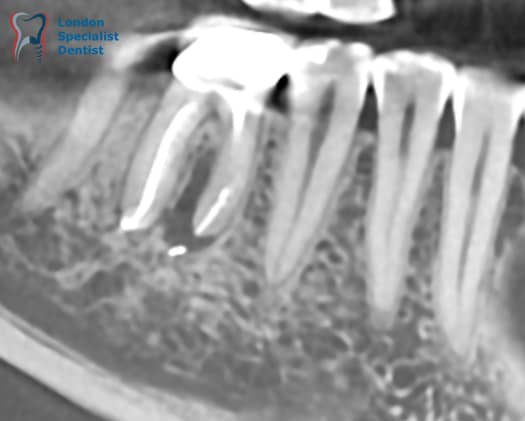
Sagittal aspect of the CBCT from infected tooth
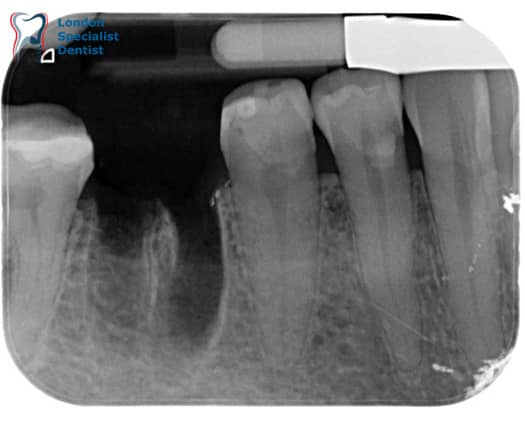
Post-Atraumatic Tooth Extraction
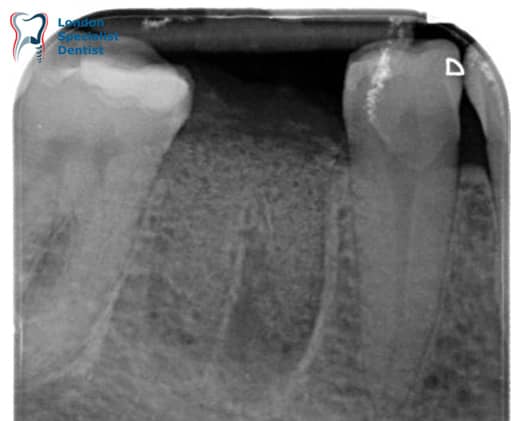
Guided bone regeneration & Ridge Preservation
Guided bone regeneration or ‘augmentation’ procedure may be performed by a specialist periodontist using various techniques and materials, including synthetic products, animal/ human derived biomaterials. Based on the amount of bone required, and the patient’s preference, one or a mixture of all these bone replacement materials may be used. Our experienced surgeons in Dentist in London Specialists Dentists apply the most scientifically approved material and techniques in the field of Bone Regeneration thorough out the surgical procedures hence to improve the long-term biological success.

